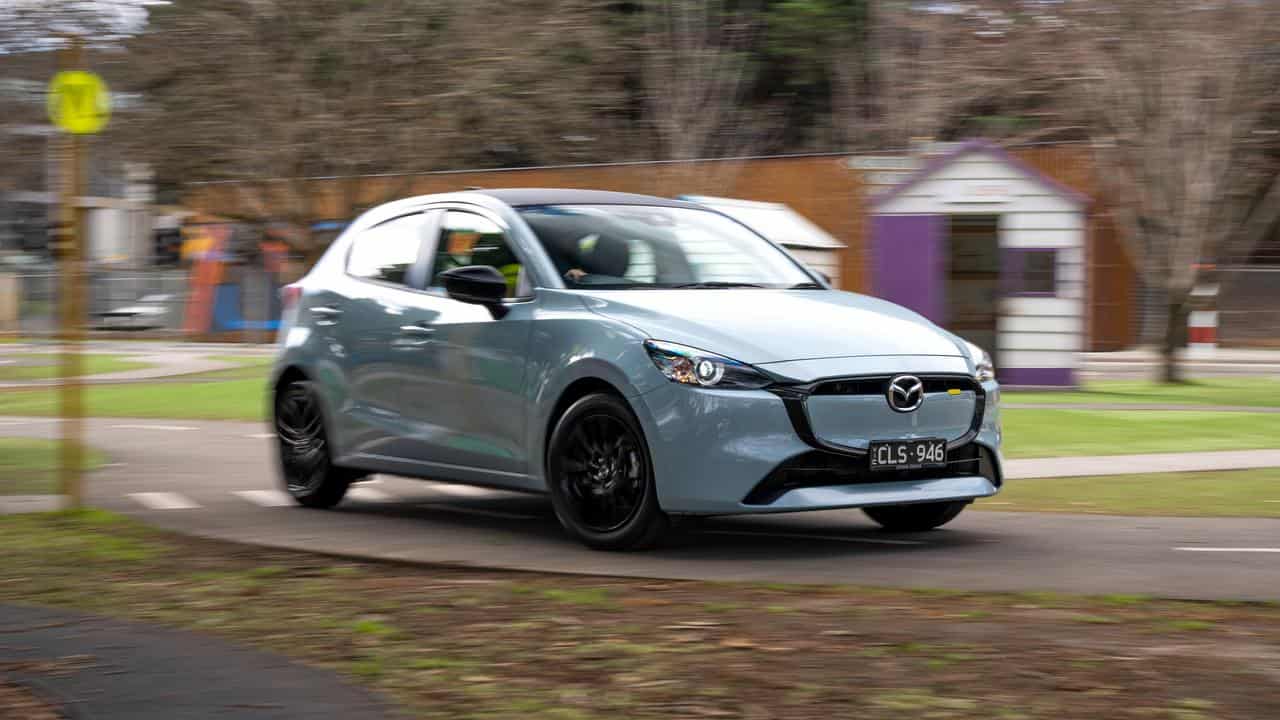
How will the small car market be affected by the growth of electric vehicles?
Both aim to achieve the same outcomes, albeit in slightly different ways.
Take the spunky little Mazda2, for instance - a smart small hatchback, and a popular seller for the Japanese marque virtually since it was launched in 2002.
The 2 was designed with dual objectives: clean urban driving at an affordable price.
Those factors are pretty much the same sought by buyers who wander into a showroom of MG, or BYD, Haval, Chery or any of the Chinese-built small cars and EVs.
The 2 is in its third generation, having recently undergone an impressive facelift. Tested here is the G15 Pure SP, which is quite a mouthful to describe what is really a very simple and delightful little machine.
The entry-level G15 Pure is one of seven variants - including hatches and sedans - offered on the little Mazda, which has been an enduring success from the Hiroshima production line.
It’s a little hard to fathom that this third-generation model has been on sale for a decade.
There have been a few cosmetic tweaks since then but mechanically and dynamically it remains pretty much the same as it was in 2014.
The new 2 offers the sporty-styled Pure SP as an entry point. The Evolve lives mid-range with equivalent equipment levels, while the GR offers more luxury and drops any access to the six-speed manual transmission. A pity, because the manual made the previous 2 lots of fun.
Prices start at $25,520 for the test machine, which shrewd observers will recognise means paying almost $1000 for the latest model.
Mazda will argue the additional cost covers more features, but that’s not entirely true.
The 1.5-litre, four-cylinder engine, for instance, has been barely upgraded in that time - from 74kW when this generation was released to 81kw in its current guise.
Accordingly this latest 2 is not exactly rapid, but it’s a well-resolved little package with a sweet-spinning engine that, once up and rolling, feels surprisingly responsive.
The six-speed automatic which feels a bit sludgy at low revs, behaves like a little terrier when the revs start to climb.
Just as importantly, it feels like a proper full-sized car on the highway, which ticks a top criteria for a small car.
It cruises comfortably at the 110km/h speed limit without feeling overstretched or overloaded, and it has a sturdy, reassuring hold on the road.
Small cars such as this can be difficult to design with so little canvas to work with (Nissan’s original Juke or Toyota’s CH-R are good examples where the styling was grossly overdone).
But it’s a problem that never has seemed to bother Mazda. The facelift on this latest model Mazda2 is proof of that - if it was wearing a different badge it would probably be called a GT or R or something similar.
But this model, from the very bottom of the range, looks a million bucks with its beautifully balanced stance, set off with some very smart black alloy wheels.
Inside, the upgrades are approached from a different angle. That is: if it ain’t broke, don’t fix it.
At first glance it looks pretty much like the model before it.

Those same classy fascia finishes, same soft-touch surfaces expected from a bigger, more expensive car, still look surprisingly up-to-date.
There’s also the same neat little instrument cluster that is mostly untouched by the upgrade. It hasn’t quite kept pace with rivals, some of whom are already offering full colour instrument panels.
That oversight is offset by the easily adjustable steering column (up and down and forward and backward) which along with comfy, cloth-covered buckets in the front make it feel quite plush. Taller passengers might prefer to skip the back seat, but few Mazda2 owners will be filling up with a handful of people.
The seven-inch centre screen is familiar to anyone who’s driven a Mazda, big or small, in recent times. In this model it’s getting a bit long in the tooth but to be honest, it’s good enough to not particularly need replacement.
It goes without saying that the cargo hatch is limited in size, but the space that is there (250 litres) is uncluttered and easy to pack. It also measures up well against rivals like the Suzuki Swift (242L) or Toyota Yaris (270L)
So, what about those electric small cars?
Mazda, no doubt in a fit affection for the planet, has included a nod to the EV brigade in the design of this car. Look at the grille and it’s virtually disappeared - replaced by an EV-style panel with an aerodynamic panel to keep the breeze out. Just like an electric machine.
MAZDA2 G15 PURE SP
* HOW BIG? It’s officially classed as a sub-compact supermini but actually feels a bit more comfortable than such a name suggests.
* HOW FAST? Be patient when leaving the traffic lights or particularly when turning across oncoming traffic. It’s not a fast starter, but gets quite engaging once its up and rolling.
* HOW THIRSTY? It consumes 5L/100km - not quite hybrid territory but it still takes a while to empty the 44-litre tank.
* HOW MUCH? The base model tested here costs $25,200 plus on road costs, almost $1000 more than the previous model.









